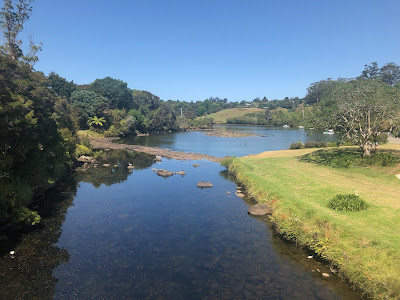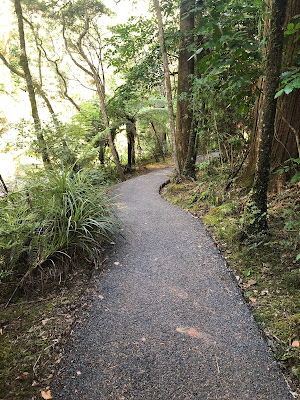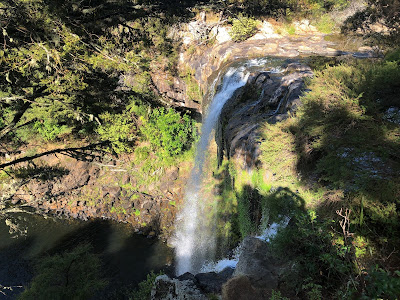Last week, I hiked along the Kerikeri River in Northland New Zealand. My destination was Waianijwaniwa, or Rainbow Falls. I'd been warned that it wouldn't be as spectacular as other times of the year due to mid-summer drought conditions, but that wasn't for me the point. I had a free day in this paradise and it was the hike that mattered.

I started out at a saunter. Fellow trail users passed me at a jog or brisk walk, clearly out for the exercise. I was not in it for physical fitness, even as I was aware that I needed to move my body as I was in the midst of a stretch of 11 airplanes over a seven day span. No, I'd undertaken this hike for the pure recreation of it, the forest bathing, the deep breathing, and, of course, the scenery. I had Eric Carle's sloth in mind, "Slowly, slowly," but my mind wandered as it tends to do on solitary walks: I've written before about my walking habit, which it really a wandering habit. This is when I do a substantial amount of my writing, which is to say my reflecting, which is to say my life's work. Plato tells us that Socrates said, "The unexamined life is not worth living," and there is nothing like a good, solitary wander for making that happen.

The signpost told me that my destination was some four kilometers distant and would take approximately an hour. I fully intended for it to take all morning. At intervals, I paused to listen, to the tumbling water, to the cacophony of insects, to the rustle of breezes in the canopy. I took a few photos, but not many: I told myself that I was not going to live this day through a viewfinder. It was a warm day, even as the trail was in shade. I began to sweat. It was an easy path, even as there were ups and downs. I began to breath deeply. Soon I noticed that I was no longer sauntering, but rather chugging along. Slowly, slowly, I said to myself, but soon I was chugging again. I wasn't being driven by the peer pressure of my fellow trail users. It wasn't that I was pressed for time. I wasn't trying to beat bad weather. I came to realize that it was my destination that pulled me.
I wasn't wandering after all, but rather
getting somewhere. There was a waterfall ahead and the longer I walked, the more I found myself anticipating it, listening for it, expecting it around the next bend or over the next rise. And it was that that was driving me.
It occurred to me that I've hiked to many waterfalls in my life, on three continents, and in at least a dozen countries. Waterfalls are worthy destinations and before long I simply gave myself over to the quest, to heavy breathing and sweat. I knew to expect smaller falls along the way: I paused to take them in, but soon moved on toward the big one. Then there they were, around a bend and without announcing themselves in the roar I typically associate with such natural phenomena due to the relative trickle of water in the river this time of year.
I was here! That was the point. I stood before them for quite some time, but before cooling down, I marched to the top of the falls, which, after all, I told myself, was my
real destination. There I sat for a long time. I then hunted for a tea house that I'd read was nearby, but it was closed for the day due to the death of a family pet.

After a time, I decided it was time to return for no other reason than that I'd decided it was time. My limbs were loose and my breathing easy. I'd seen all this before, which is the nature of a return trip. I wasn't headed home, but it was back toward the place I was staying in the Kerikeri Basin. I wasn't hungry, but knew I would be after another hour on the trail. As I descended back down into the forest, everything was different. Now I really could saunter. Now I really could wander. Now I really could reflect. It wasn't the sloth that was on my mind now, but rather Maurice Sendak's Max on the return from his wild rumpus amongst the wild things. I took my time, stopping often, anticipating the lunch that awaited me, but not with the urgency of the waterfall, but rather with the knowledge that I'd acquired a kind of mastery. It was the difference between the familiar and unfamiliar, the old and the new. This trail was now known to me whereas only moments before I had passed through it as unknown on my way to an unknown.

This is the story of learning, of living. It's often told as a circle, always returning to the same place, but it's a coming and going as well. Or perhaps it's a story better told as a kind of spiral, because even as we return to the same place, it's different because the outward journey changes us and we, in turn, upon our return, change the place we call "home," which is the ultimate purpose of any journey, be it a wander or quest: to go somewhere else and bring something back. And our world will never be the same.